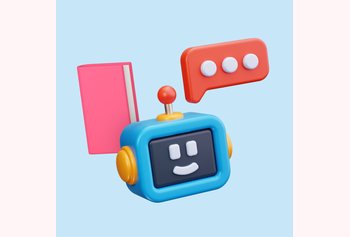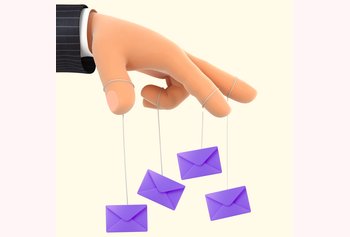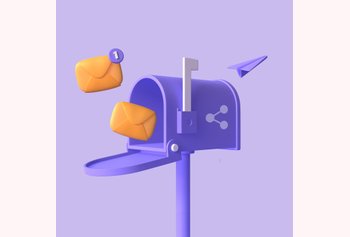9 Things to Consider When Switching Help Desks
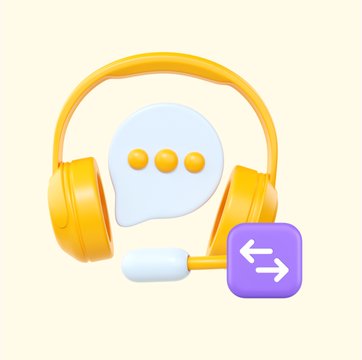
Table of contents
As your company grows and its customer base expands, the customer support department will have to deal with an exponentially higher influx of customer queries and issues.
And your current help desk can only do so much.
This calls for switching to a new, more powerful help desk platform.
However, switching to a new help desk can be disruptive. It’s like renovating a house while still living in it.
There’s data to migrate, teams to train, and new workflows to learn. How can you make the switch without impacting your team’s ability to help customers?
This blog discusses nine straightforward steps to ensure a smooth transition to your new help desk.
Table of Contents
- Why Consider Switching to a New Help Desk?
- 9-Step Guide to Switching Help Desks
- Step 1: Assess Current Help Desk Performance
- Step 2: Define Your Requirements and Objectives
- Step 3: Research Help Desk Solutions
- Step 4: Evaluate Costs and Return on Investment (ROI)
- Step 5: Plan for Data Migration and Integration
- Step 6: Implement the New Help Desk System
- Step 7: Provide Ongoing Support and Training
- Step 8: Evaluate Performance and Iterate
- Step 9: Conduct Regular Reviews and Audits
- Frequently Asked Questions (FAQs)
- Conclusion
Why Consider Switching to a New Help Desk?
Your current helpdesk is lacking important features. It might have been sufficient when you had a smaller team but now, you want more powerful features such as automation or advanced reporting.
Below are some reasons why switching to a new help desk would be worth considering:
- Cost Issues: “You know, we’re paying quite a bit for our current help desk, and I’m not sure we’re getting our money’s worth. It might be a good idea to see if there’s a more budget-friendly option that still meets our needs.”
- Tricky Interface: “Our helpdesk interface is quite clunky. It can be really frustrating to use, which slows everything down. Maybe we should look for something that’s easier to navigate.”
- Missing Features: “As we’re growing, it feels like our current system just can’t keep up. We’re missing some key features that could really make a difference. It might be time to find a help desk that can handle our expanding needs.”
- Scalability Problems: “I’ve been thinking about how our help desk seems to struggle as we add more people and more tasks. We need something that scales better with our growth.”
- Reliability Issues: “It seems like our help desk is always down when we need it most. We might need to switch to a system that’s more reliable and doesn’t leave us hanging.”
9-Step Guide to Switching Help Desks
Switching help desks should not stress you out. We’ve made the process smooth by breaking it down into nine easy-to-follow steps.
Step 1: Assess Current Help Desk Performance
Before making any changes, it’s important to understand how well your current help desk is working. Here’s what you need to do:
- Speak with your support team on how easy or challenging it is to use the existing help desk. Are they finding it difficult to navigate the interface? Is pulling some reports becoming an issue? These are some of the pain points that can surface.
- Look at how quickly and efficiently your customer support team resolves queries – using the help desk.
Basically, figure out the strengths and weaknesses of your current help desk. And look for any recurring issues that might indicate a need for change.
In the words of Christian Sokolowski, Vice President of Customer Support at Rebuy Engine, “The first step in considering a new help desk platform is to clearly understand your objectives. Are you seeking cost savings or enhanced functionality?”
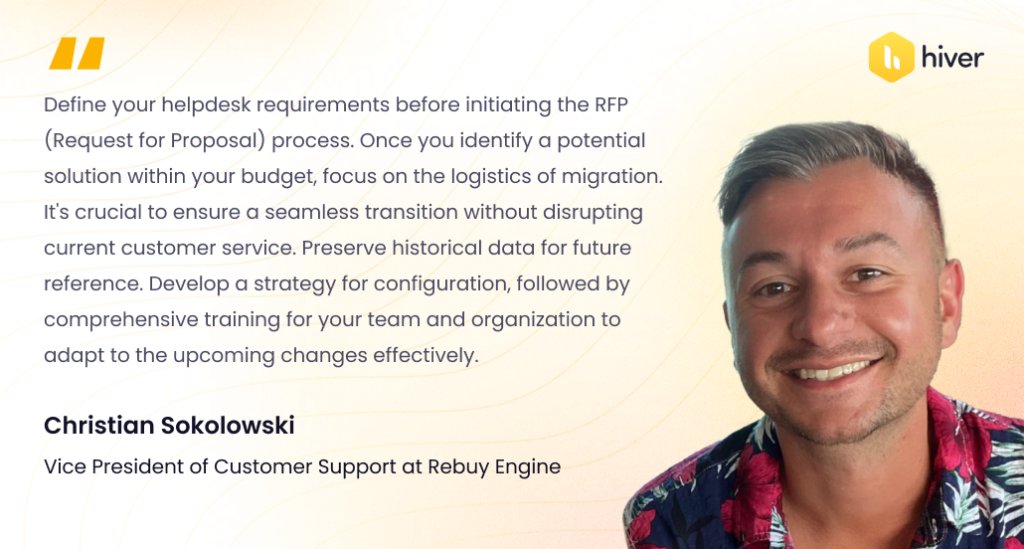
Step 2: Define Your Requirements and Objectives
Next, you need to know exactly what you want from a new help desk. Here’s how to do it:
- Start by creating a detailed list of what you need your new help desk to do – like handling more tickets or integrating with necessary tools.
- Decide which features are essential and which would just be nice to have. Would AI or automation features help? Do you need more advanced reporting functionalities?
Tip: As your company grows fast, you need a help desk that can keep up. Hiver transforms Gmail into a shared inbox, making it easy for teams to manage support and sales emails collaboratively. This setup helps prevent duplicate responses and ensures no customer query is overlooked.
Step 3: Research Help Desk Solutions
Once you know what you need, it’s time to start looking for potential help desk solutions available in the market. Here’s how to conduct your research effectively:
- Look into different help desk software providers and compare their features, pricing, and customer reviews. (Check sites like G2, Capterra, and Software Advice for customer feedback).
- Reach out to vendors to schedule demos or trials of their software so you can see how it works firsthand.
- Verify that the help desk can integrate smoothly with your existing tools and systems to minimize disruptions.
Sarah Caminiti, the Vice President of Customer Success at DNSimple, suggests, “Take that list and make yourself a good old spreadsheet. Maybe make a grading system with the ‘needs’ holding one point value and the ‘wants’ holding another.”
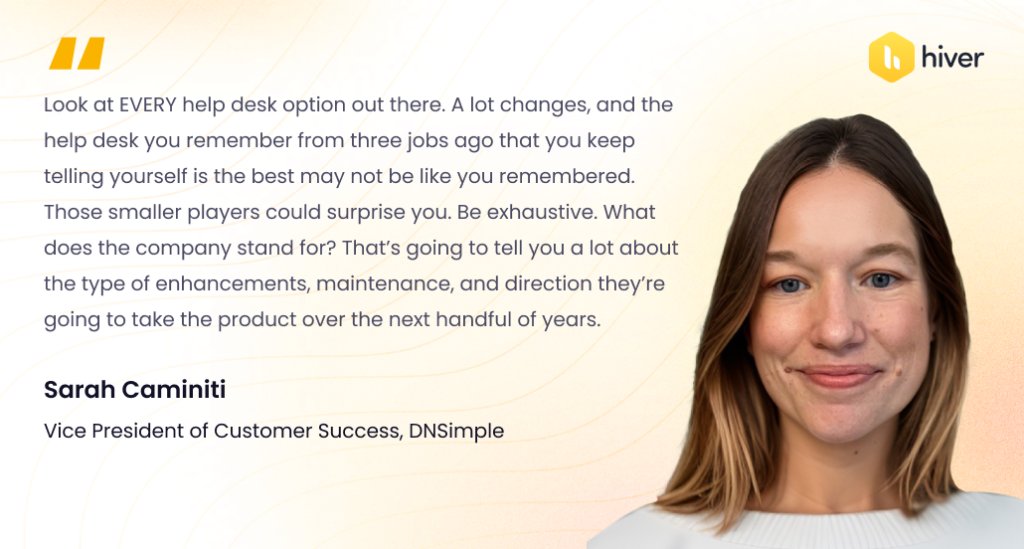
Step 4: Evaluate Costs and Return on Investment (ROI)
This is one of the most important steps. Assess the costs associated with implementing a new help desk and the potential return on investment. Here’s how to evaluate the financial aspect:
- Compare the pricing structures of different help desk software, including subscription fees, setup costs, and any additional charges.
- Factor in all associated costs over the lifetime of using a help desk, including ongoing maintenance, upgrades, and support.
[For instance, Zendesk can cost almost twice as much as Hiver, depending on the plan and features you choose. From both a feature parity and pricing standpoint, opting for Hiver could result in significant savings per user.]
Tip: If one help desk has a higher upfront cost but offers significant time savings, it may ultimately provide a better ROI than a cheaper alternative. Calculating the TCO (Total Cost of Ownership) can help you make a more informed decision.
Step 5: Plan for Data Migration and Integration
Moving to a new help desk involves migrating existing data and integrating the new system with your current tools and processes. Here’s how to plan for a smooth transition:
- Identify what data needs to be transferred to the new help desk, such as customer information, ticket history, and knowledge base articles.
- Create a detailed plan outlining the steps involved in migrating data, including any necessary data cleansing or formatting.
- Conduct test migrations to ensure that data is transferred accurately and without errors.
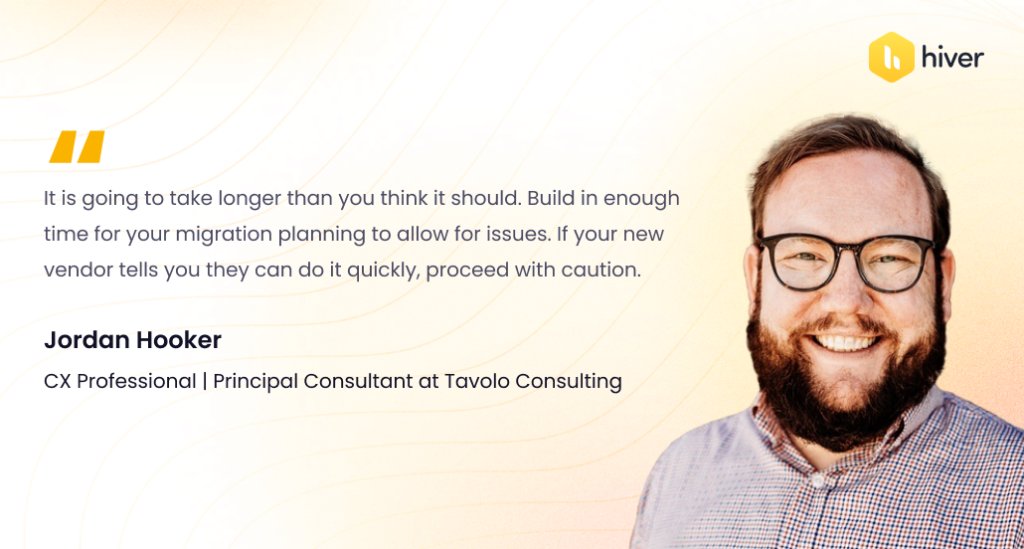
Step 6: Implement the New Help Desk System
With careful planning and preparation, it’s time to implement the new help desk system. Follow these steps to ensure a successful rollout:
- Install and configure the new help desk software according to your organization’s requirements and specifications.
- Conduct thorough testing of the help desk system to identify and address any issues or bugs before going live.
- Inform all stakeholders, including employees and customers, about the upcoming changes to the help desk system and provide training or resources as needed.
When we asked Jordan about one of the biggest issues he sees companies encounter when going live with a new help desk system, he said, “They fail to consider the need for a rollback plan. Be prepared for the possibility that something could go wrong and a rollback to your older system is needed to maintain operations. You’ll be glad you had the plan in place!”
Step 7: Provide Ongoing Support and Training
Switching to a new help desk system isn’t just about implementation; it also requires ongoing support and training.
Conduct regular training sessions to help your support team familiarize themselves with the new help desk system’s features and functionality. The training schedule can look something like this:
- Week 1: Introduction to the new help desk system, focusing on basic navigation and the ticketing process.
- Week 2: Deep dive into specific features like managing queues and using the knowledge base.
- Week 3: Interactive role-play sessions where team members practice handling typical customer scenarios using the new system.
Also, create comprehensive documentation, including user guides and FAQs, to serve as quick references. Designate a team or individual to provide ongoing support and troubleshooting for users encountering issues with the help desk.
With Hiver, your teams can get started in minutes. No need for additional training.

Step 8: Evaluate Performance and Iterate
Keep an eye on the performance of your new help desk. Here’s how to evaluate performance and make iterative improvements:
- Track key performance indicators (KPIs) such as response time, average handling time, and customer satisfaction score to assess the help desk system’s effectiveness.
- Keep an eye on help desk downtime, as well as any bugs or glitches that occur. Frequent downtime or persistent software issues can significantly affect your team’s ability to provide timely support.
Step 9: Conduct Regular Reviews and Audits
Regular reviews and audits are essential to ensure that your help desk system continues to meet the evolving needs of your organization. Here’s how to conduct them effectively:
- Establish a schedule for reviewing your help desk system regularly, such as quarterly or annually.
- Collect feedback from both internal users (e.g., support team) and external users (e.g., customers) to gain insights into their experience and identify any pain points or areas for improvement.
- Conduct periodic audits of the help desk system to ensure compliance with internal policies, industry regulations, and best practices.
Frequently Asked Questions (FAQs)
Here are some common questions related to switching help desks:
1. How long does it take to switch help desks?
The time it takes to switch help desks can vary depending on factors like the complexity of your current setup and the chosen replacement. It typically involves several weeks to months of planning, implementation, and training.
2. What should we consider when choosing a new help desk?
When choosing a new help desk, consider factors like scalability, ease of use, integration with existing tools, cost, and vendor support. Prioritize features based on your organization’s specific needs and objectives.
3. How does switching to Hiver from our current help desk benefit our team?
Switching to Hiver can benefit your team by providing a seamless email management solution directly within Gmail. It streamlines communication, improves collaboration, and enhances productivity by eliminating the need to switch between multiple tools for email and task management.
4. Is it difficult to migrate our existing data to Hiver?
No, migrating existing data to Hiver is straightforward. Hiver offers easy-to-use tools and 24×7 support to help you migrate emails, contacts, and other relevant data from your current help desk or email platform, ensuring a smooth transition without data loss.
5. Can Hiver integrate with our existing tools and workflows?
Yes, Hiver seamlessly integrates with various third-party tools and platforms commonly used in business workflows, such as CRM systems, project management tools, and collaboration platforms. This ensures compatibility and enhances productivity by centralizing all communication and tasks within Gmail.
Conclusion
Switching to a new help desk solution may seem daunting, but these 9 steps are here to guide you through it. By carefully assessing your current help desk, defining your needs, and researching potential options, you can make an informed decision that benefits both your team and your customers.
Hiver, for instance, is a powerful tool that simplifies email management and customer support. With its easy-to-use interface and seamless integration with Gmail, Hiver makes communication and collaboration straightforward.












